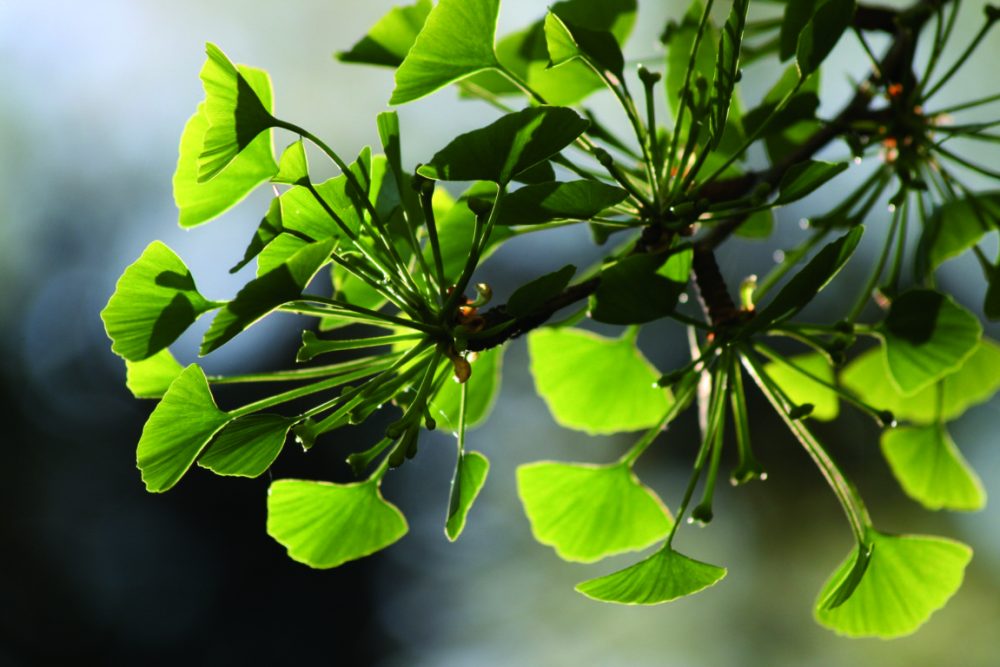Ginkgo Biloba
The ginkgo biloba in front of us is one of the five monumental specimens in the Park. At over 200 years old, it is truly a "lady". In autumn, it is easy to distinguish the male trees from female ones, the females are laden with fruits that typically start falling from the tree between late September and November.
The ginkgo biloba is a conifer whose origins date back 250 million years, and for this reason, it is also known as the "living fossil." The French call it l'Arbre aux mille écus, the tree of a thousand shields, while the English call it Maidenhair. The name ginkgo likely comes from a mistake in the transcription of the Japanese word yin-kuo: Yin, silver, and kyo, apricot, referring to the appearance of its fruit. The species name, biloba, comes from the Latin bis and lobus, referring to the leaf's division into two fan shaped lobes lobes.
The French call it l'Arbre aux mille écus, or the tree of a thousand crowns. In Chinese culture, the bilobed shape of the leaves symbolizes the coexistence of yin and yang, the two energies governing human life, things, and nature. Goethe, in a poem named after this tree, similarly wrote: "Do you not feel, in my songs, that I am both one and double?"
The ginkgo biloba withstands cold and drought and is immune to insects, fungi, parasites, air and industrial pollution. It is said that some trees sprouted shortly after the atomic bomb exploded in Hiroshima, earning the title of "trees of peace". The ginkgo biloba is a botanical curiosity. It is like Turandot, a sense of wonder when observing a conifer with flat, fan-shaped leaves, behind which elusive smiles and fleeting glances seem to hide. In autumn, the yellow of the ginkgo biloba in the garden is like a gaze, a blink of an eye; it shifts position, opens, and stands vertical like a waterfall, then closes, horizontal like a carpet.

The ginkgo biloba in front of us is one of the five monumental specimens in the Park. At over 200 years old, it is truly a “lady”. In autumn, it is easy to distinguish the male trees from female ones, the females are laden with fruits that typically start falling from the tree between late September and November.
The ginkgo biloba is a conifer whose origins date back 250 million years, and for this reason, it is also known as the “living fossil.” The French call it l’Arbre aux mille écus, the tree of a thousand shields, while the English call it Maidenhair. The name ginkgo likely comes from a mistake in the transcription of the Japanese word yin-kuo: Yin, silver, and kyo, apricot, referring to the appearance of its fruit. The species name, biloba, comes from the Latin bis and lobus, referring to the leaf’s division into two fan shaped lobes lobes.
The French call it l’Arbre aux mille écus, or the tree of a thousand crowns. In Chinese culture, the bilobed shape of the leaves symbolizes the coexistence of yin and yang, the two energies governing human life, things, and nature. Goethe, in a poem named after this tree, similarly wrote: “Do you not feel, in my songs, that I am both one and double?”
The ginkgo biloba withstands cold and drought and is immune to insects, fungi, parasites, air and industrial pollution. It is said that some trees sprouted shortly after the atomic bomb exploded in Hiroshima, earning the title of “trees of peace”. The ginkgo biloba is a botanical curiosity. It is like Turandot, a sense of wonder when observing a conifer with flat, fan-shaped leaves, behind which elusive smiles and fleeting glances seem to hide. In autumn, the yellow of the ginkgo biloba in the garden is like a gaze, a blink of an eye; it shifts position, opens, and stands vertical like a waterfall, then closes, horizontal like a carpet.
